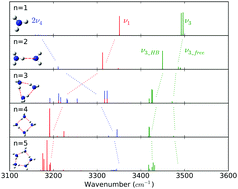An ab initio anharmonic approach to study vibrational spectra of small ammonia clusters†
Abstract
Fermi resonance between the N–H stretching (ν1 and ν3) and the overtone of N–H bending (2ν4) in ammonia has hindered the interpretation and assignments of experimental spectra of small ammonia clusters. In this work, we carried out anharmonic vibrational calculations using MP2/aug-cc-pVDZ to examine the vibrational spectra of (NH3)n=1–5 with a focus on the size evolution. The enhancement of hydrogen bond strength due to cooperative effects will cause ν1 and ν4 to red-shift and blue-shift, respectively, when the size of the cluster increases. Our calculations show that the energy order of fundamental of ν1 and overtone of ν4 is reversed between n = 3 and n = 4. Therefore, while the resultant mixed levels do not show remarkable shifts in their peak positions, the main identity of these mixed levels changes and this causes significant re-distribution of their intensities. Furthermore, our ab initio anharmonic calculation scheme can directly evaluate the coupling strength between different N–H stretching and overtone of N–H bending without any experimental parameters, thus leading us to a simpler picture to understand the Fermi resonance in (NH3)n.


 Please wait while we load your content...
Please wait while we load your content...